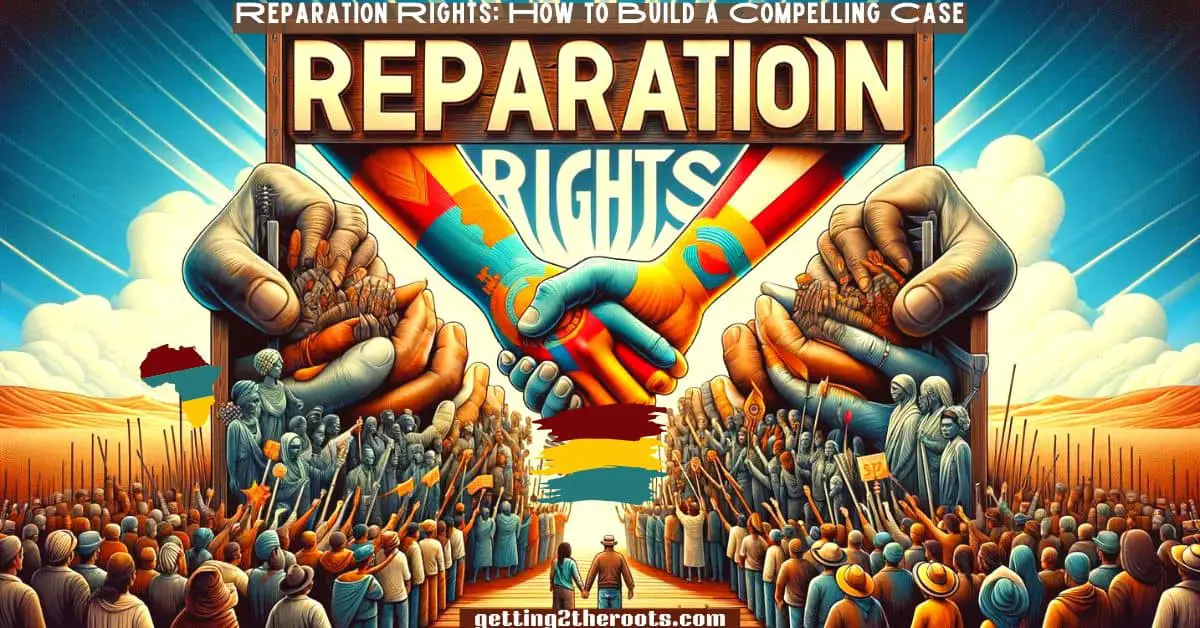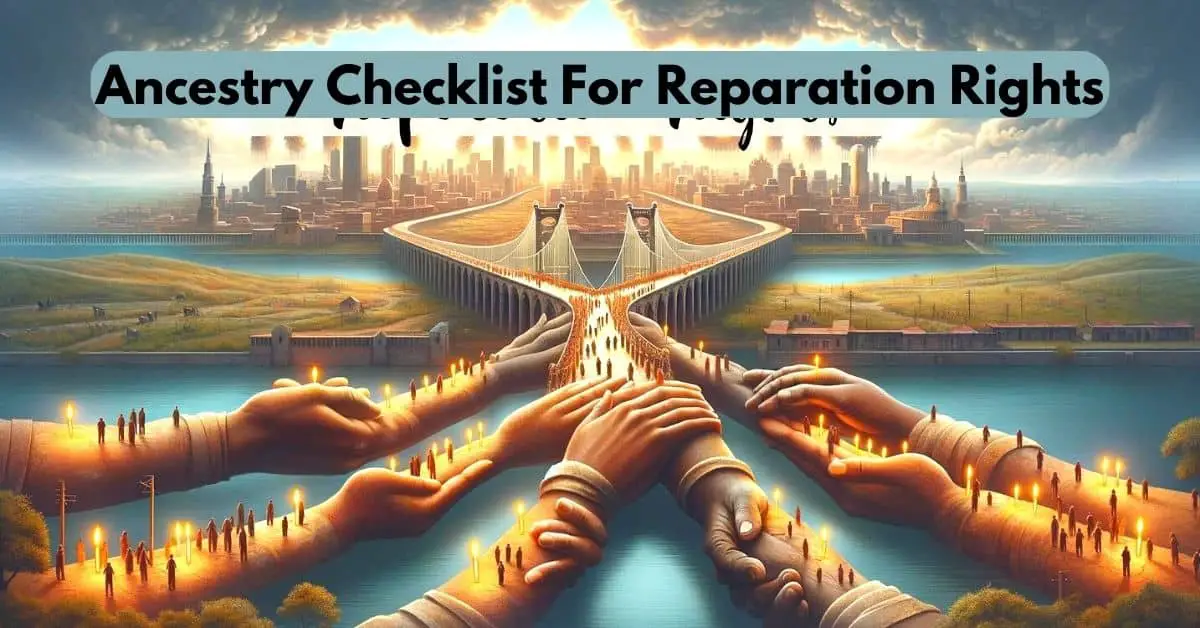Reparation rights have emerged as a pivotal issue, especially for descendants of the enslaved. This concept revolves around the idea of compensating these individuals for the injustices their ancestors faced.
Moreover, it seeks to address the systemic inequalities that persist as a result of historical slavery.
But as we delve into this topic of reparation rights, we aim to underscore its importance. We aim to provide a pathway for individuals to explore their heritage.
Reparation rights play a crucial role in acknowledging the past wrongs inflicted upon our ancestors by the enslaved.
They serve as a step towards rectifying historical injustices and fostering a sense of healing and closure for affected communities.
Furthermore, understanding reparation rights empowers descendants to claim what is rightfully theirs, paving the way for a more equitable future.
How Have Reparation Rights Evolved?
The movement for reparations is not new; it has roots that trace back centuries. Initially, it focused on direct compensation for the survivors of slavery.
However, the scope has broadened over time. Today, the movement encompasses a wider range of compensatory measures, including:
- Educational opportunities,
- Healthcare access,
- Economic support.
This shift reflects a growing recognition of the multifaceted impact of slavery on descendants.
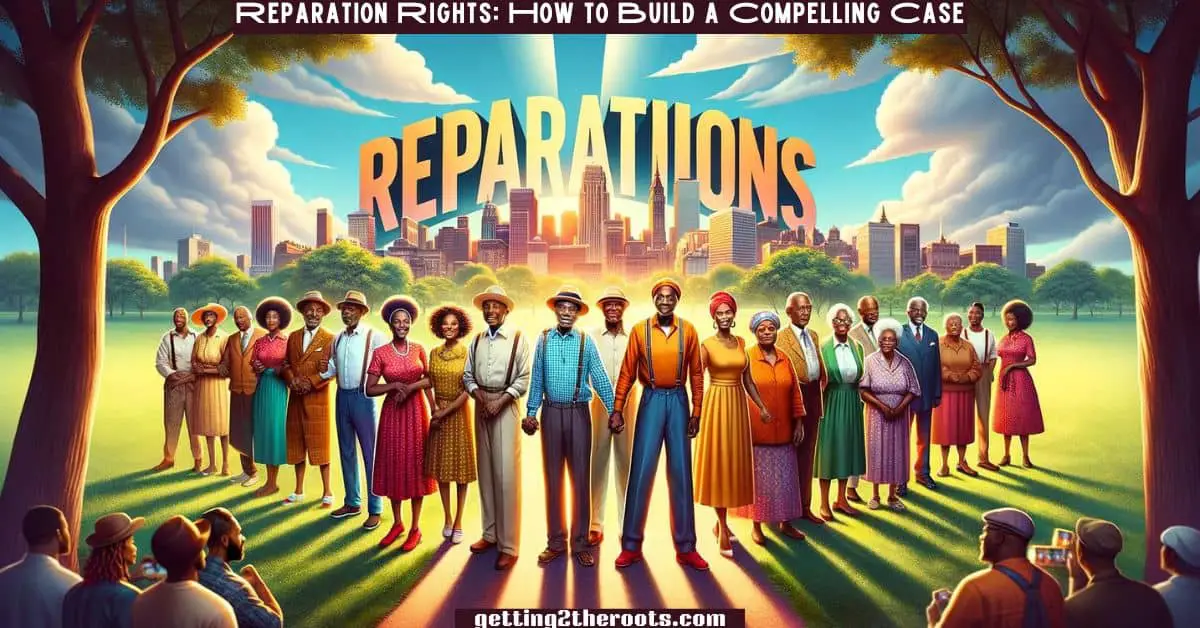
Understanding the Purpose and Scope of This Reparation Rights Guide
This guide is designed to assist individuals in navigating the complex process of proving their roots for reparation rights.
It aims to demystify the steps involved and provide practical advice on gathering the necessary documentation and evidence.
Focusing on reparation rights, we aim to provide a valuable resource. It’s designed for individuals seeking to reclaim their heritage and secure their rightful compensation.
Throughout this guide, we will explore the significance of reparation rights, offering insights and strategies to effectively prove one’s lineage.
By grasping the nuances of reparation rights, descendants can more effectively advocate for their entitlements.
This understanding also allows them to contribute significantly to the broader reparations movement.
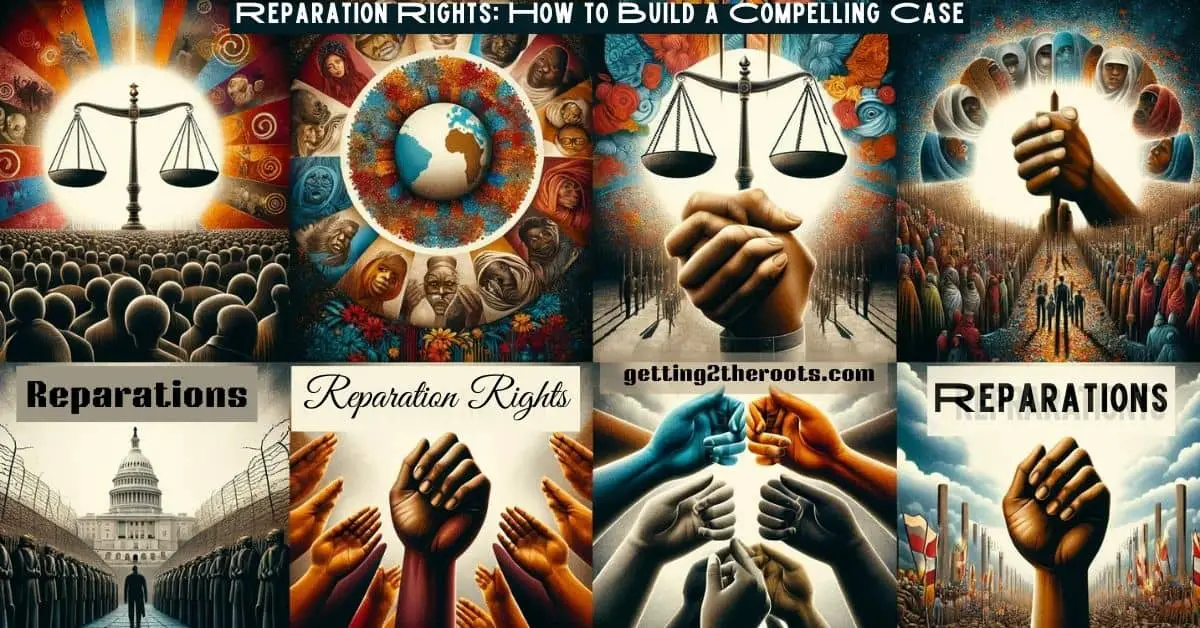
Reparation Rights How to Build a Compelling Case?
Definition and Types of Reparations
Reparation rights encompass a range of compensatory actions aimed at rectifying past injustices.
Essentially, these rights advocate for measures that provide restitution to the descendants of the enslaved.
Reparations can take various forms, including:
- Financial compensation,
- Land redistribution,
- Educational scholarships,
- Public apologies,
- Policy reforms.
Each type serves a specific purpose, aiming to address different facets of the injustices suffered by ancestors.
Hence, understanding the diversity of reparation rights is crucial for descendants seeking justice and recognition.
Legal and Moral Grounds for Reparations
The quest for reparation rights stands on both legal and moral foundations. Legally, this concept is rooted in international human rights laws. These laws acknowledge the right to a remedy for victims of gross human rights violations.
Morally, it is rooted in the principle of justice, acknowledging that the horrors of slavery and its lasting impacts warrant redress.
This dual grounding bolsters the reparations movement’s legitimacy. It offers a strong framework for descendants to advocate for their rights.
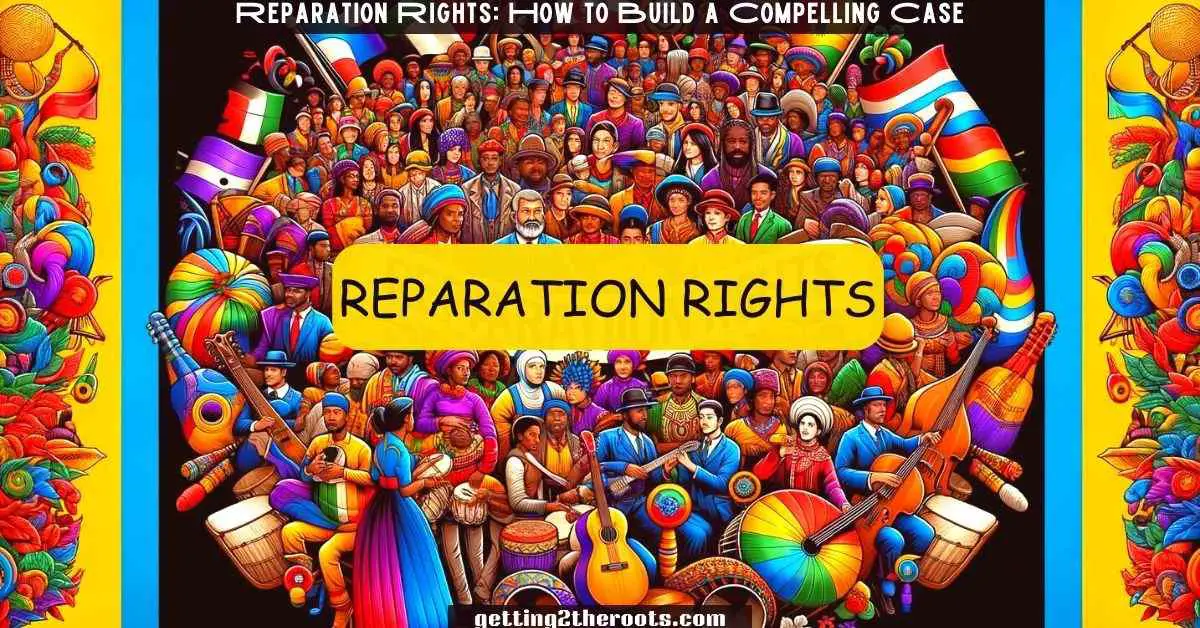
Global Examples of Reparations Efforts
Examining global efforts for reparation rights reveals a tapestry of approaches and successes. For instance, Germany’s reparations to Jewish survivors of the Holocaust stand as a significant precedent, involving direct compensation and restitution.
Similarly, the Japanese-American redress movement in the United States led to the Civil Liberties Act of 1988. This act compensated survivors of internment camps during World War II.
These examples, among others, demonstrate the potential of reparations to foster reconciliation and healing.
They also offer valuable lessons for current reparation rights movements, highlighting the importance of persistence, legal strategy, and public advocacy.
Through understanding the definition, legal and moral grounds, and global examples of reparations, we gain insight into the complexity and potential of reparation rights.
This knowledge not only empowers descendants of the enslaved but also enriches the broader discourse on justice and equity.
As we move forward, it’s essential to keep in mind the significance of reparation rights in shaping a more just world.
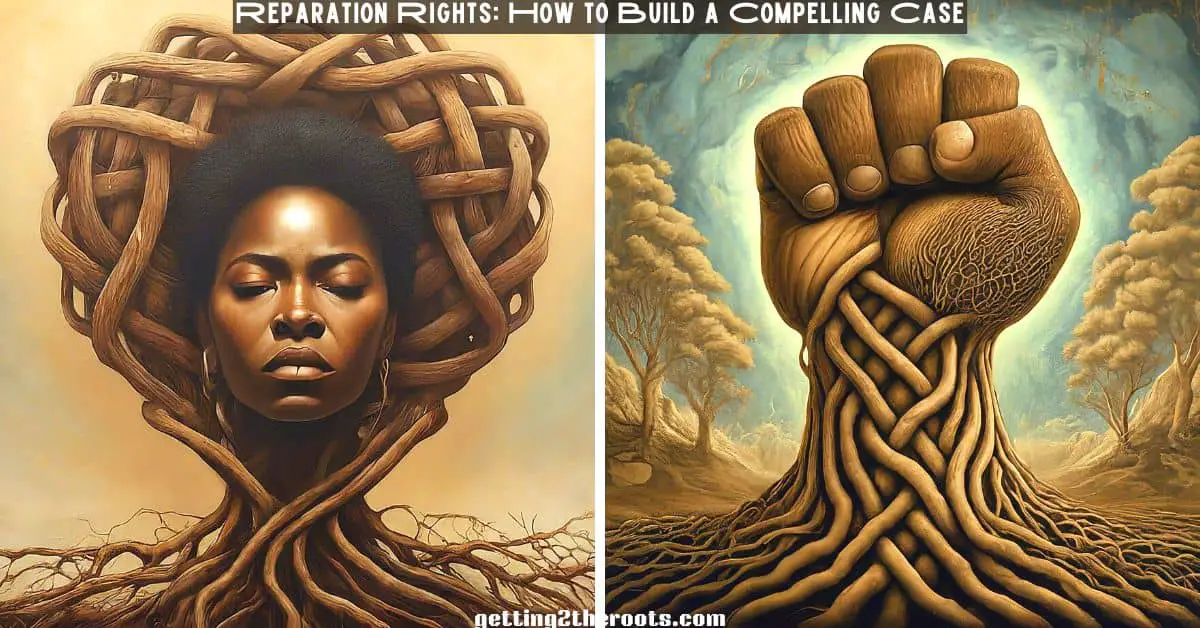
The Importance of Ancestry in Reparation Rights Claims:
Role of Genealogical Evidence in Reparation Rights Claims
Genealogical evidence acts as the cornerstone in the pursuit of reparation rights. This evidence provides a crucial link between present-day individuals and their ancestors, who suffered injustices.
By meticulously tracing family lineages, descendants can establish their eligibility for reparations.
Documents such as birth certificates, marriage records, and historical census data play pivotal roles in this process.
Effectively, these pieces of evidence serve not just as a bridge to the past but as a foundation for claims, underscoring the undeniable connection between generations.
Discover the essentials of tracing your ancestry with “Ancestors’ Research: A Free Beginner’s Guide” [Click Here].
This guide is a must-read for anyone starting their journey towards reparations, offering clear, step-by-step advice to uncover your heritage and strengthen your claim.
Challenges and Considerations in Tracing Ancestry
Despite its importance, tracing one’s ancestry presents numerous challenges. Firstly, historical records are often incomplete or inaccessible, making the task daunting.
Additionally, the legacy of slavery has erased or obscured many familial links, leaving gaps in genealogical records.
Descendants must navigate these obstacles with determination and creativity, sometimes relying on DNA testing and community oral histories to piece together their ancestry.
Discover your roots! Read ‘The Best DNA Testing Companies For Finding Ancestors‘ [Click Here] and begin your ancestry journey today.
It’s crucial to approach this task with patience and resilience, recognizing that each discovered connection reinforces the basis for reparation rights claims.
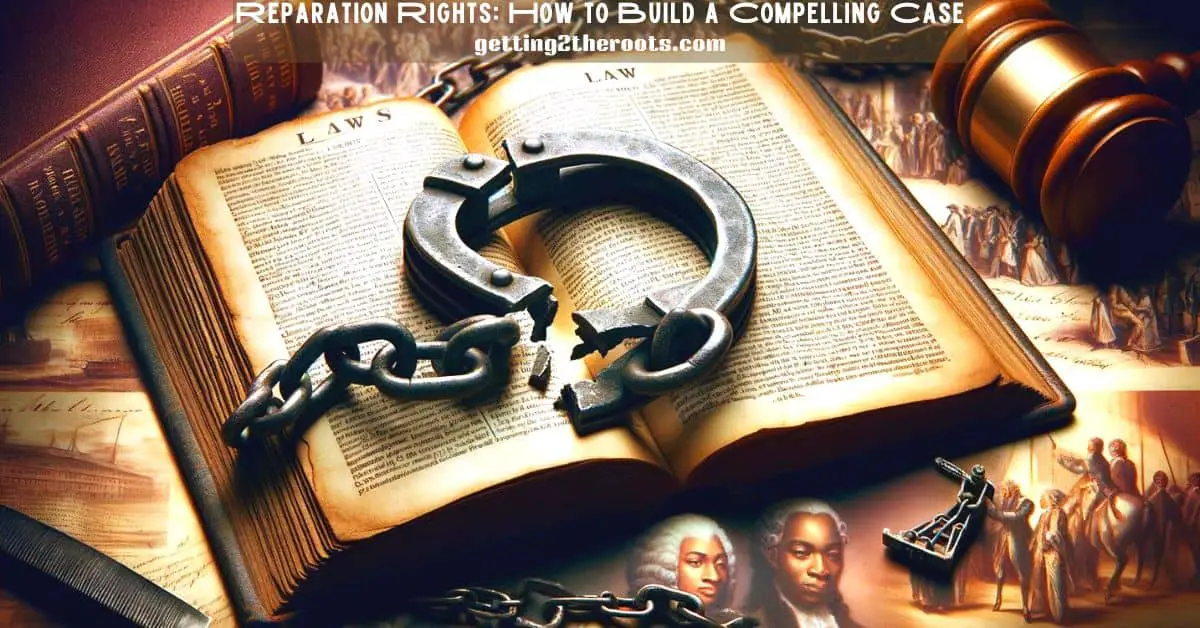
Case Studies of Successful Ancestry-Based Reparations Claims
Examining successful case studies sheds light on the tangible impact of genealogical evidence in securing reparation rights.
For instance, the compensation awarded to descendants of the Tulsa Race Massacre victims highlights the power of well-documented ancestry claims.
These families presented clear genealogical links to the affected individuals, leading to recognition and reparations.
Another example can be found in the Caribbean, where descendants of enslaved people have leveraged ancestral evidence to push for reparations from former colonial powers.
These case studies not only demonstrate the potential for success but also inspire and guide others in their quest for justice.
The role of ancestry in reparation rights claims is undeniably crucial. By understanding;
- The importance of genealogical evidence,
- Navigating the challenges of tracing ancestry,
- Learning from successful case studies,
- Descendants can strengthen their claims.
Not only does this article illuminate the path toward reparation rights but it also emphasizes the power of connecting with one’s past to rectify historical injustices.
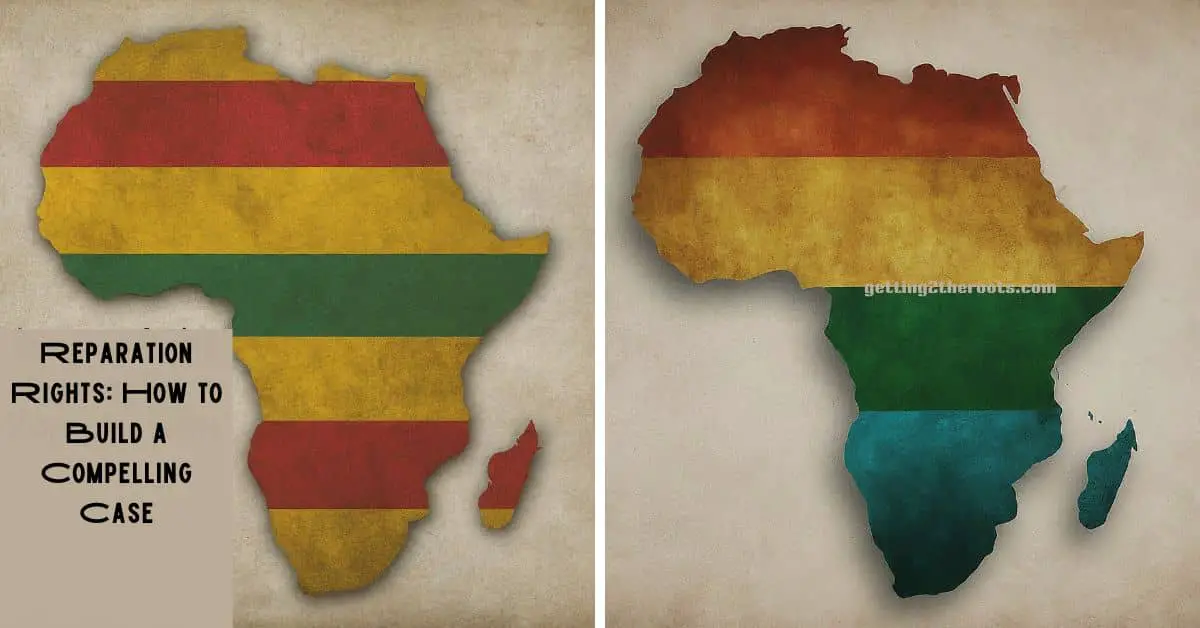
Starting Ancestral Research for Reparation Rights: Where to Begin?
Dive into your heritage with ‘Unlocking Your Past: The Journey to Trace Your Ancestors.’ This essential YouTube video series guides you through the steps to discover your lineage and prove your descent from the enslaved.
Explore tools, tips, and stories that bring your family’s history to light. Begin your ancestry journey today [Click Here]. Your ancestors’ stories are waiting to be uncovered.
Preliminary Steps: Understanding What Information You Need
Embarking on ancestral research begins with understanding the specific information required for reparation rights claims.
Identifying the names, birthplaces, and dates of ancestors is essential. This initial step involves compiling any known family history and identifying gaps in knowledge that need filling.
Creating a detailed plan to gather the missing information is crucial. This plan should prioritize obtaining documents directly linking you to your ancestors, such as property records, wills, and historical census reports.
Recognizing the type of evidence needed not only streamlines the research process but also significantly enhances the credibility of reparation rights claims.
Resources for Beginning Your Search
- Fortunately, a wealth of resources are available to aid in the search for ancestral information.
- Archives, both national and local, offer access to a vast array of historical documents.
- Online databases and genealogical websites have made it easier than ever to uncover family histories from the comfort of one’s home.
- Libraries and historical societies often hold unique collections that can provide insights into the lives of ancestors.
- Additionally, social media and online forums can be invaluable resources, offering opportunities to connect with distant relatives and share information.
- Leveraging these resources effectively can uncover crucial links in your family tree, strengthening your claim to reparation rights.

Working with Genealogists and Historians
For those who encounter obstacles in their research or seek to deepen their ancestral understanding, working with professional genealogists and historians can be highly beneficial.
These experts can navigate complex historical records, interpret findings, and uncover connections that might otherwise remain hidden.
They bring a wealth of experience in solving genealogical puzzles, especially in cases where records are scarce or difficult to interpret.

Engaging with professionals can streamline the research process, making it both efficient and rewarding.
This collaboration lays a solid foundation for reparation rights claims, anchored in a thoroughly documented ancestral lineage. Embarking on the journey of ancestral research is a crucial step towards securing reparation rights.
By grasping the required information, tapping into available resources, and leveraging the expertise of genealogists and historians, descendants can unearth their roots. This process empowers them to fortify their claims.
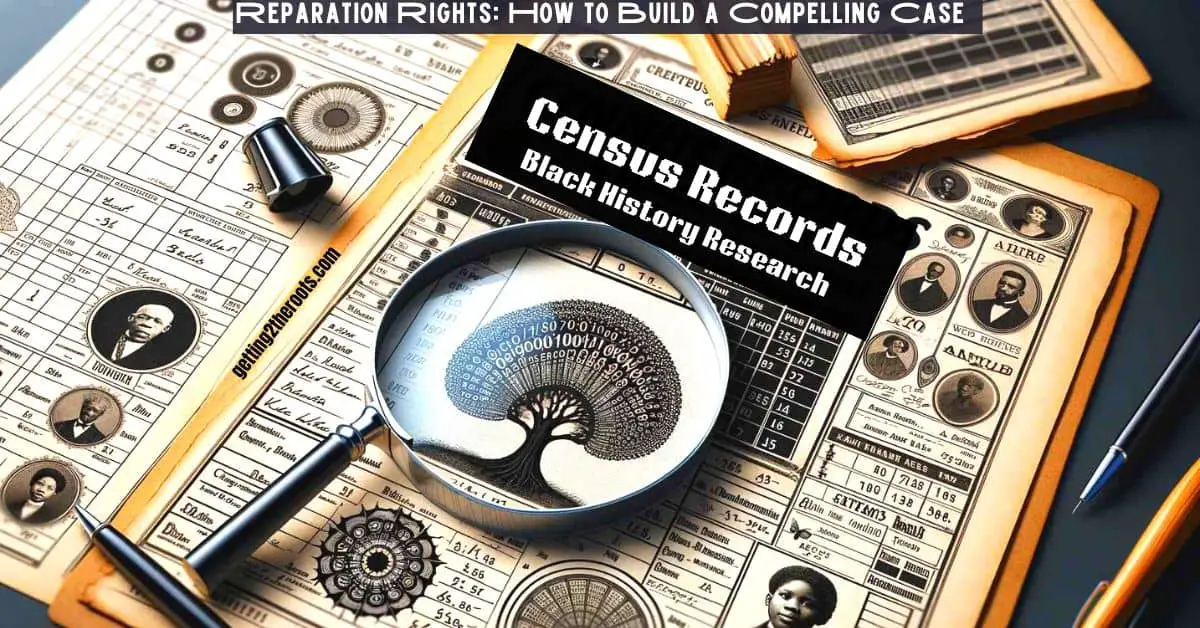
Key Documents and Records for Reparation Rights
Dive into your past! Explore ‘How To Understand the Landscape of Online Genealogy Records‘ [Click Here] and unlock your ancestry now.”
Overview of Vital Records for Reparation Rights
Vital records, including birth, marriage, and death certificates, are fundamental in establishing a direct lineage for reparation rights claims.
These documents serve as official evidence of an individual’s existence and familial relationships.
- Birth certificates can verify ancestry.
- While marriage certificates establish connections between different family branches.
- Death certificates, on the other hand, can provide important details about an individual’s life and death, often leading to further genealogical evidence.
- Collecting these records is a crucial first step in documenting your heritage for reparation rights.
Census Records and Slave Schedules
Census records are invaluable for tracing ancestors back through the generations. They offer snapshots of family compositions, residences, occupations, and more across decades.
Specifically, for descendants of enslaved individuals, the U.S. Federal Census Slave Schedules of 1850 and 1860 provide names and genders for enslaved ancestors.
These records can sometimes link individuals to a specific location or owner, which is essential for reparation rights claims.
Navigating these records requires patience and persistence but can yield significant insights into one’s lineage.
Unlock your history now! Explore ‘The Value of Freedman’s Bank Records for Genealogy‘ for lineage clues [Click Here], then master pre-1870 ancestry with ‘Best Strategies: Revealing African American Ancestry Before 1870‘ [Click Here]. Dive deeper into your genealogy journey today!

Wills, Property Deeds, and Manumission Records
Wills may reveal relationships and familial hierarchies, while property deeds can establish long-term residence and ownership, reflecting the family’s historical presence in a region.
Manumission records, which document the freeing of enslaved individuals, are particularly poignant, providing names and sometimes family connections.
These documents collectively offer a tangible link to the past, solidifying claims for reparations.
Using DNA Testing to Supplement Documentary Evidence
When documentary evidence is scarce or incomplete, DNA testing emerges as a powerful tool for establishing ancestry.
It can reveal genetic connections to specific regions or populations, offering clues to an individual’s heritage.
Furthermore, DNA testing can connect descendants with living relatives, expanding the family tree and potentially uncovering new avenues for documentary research.
While DNA results alone may not suffice for reparation rights claims, they can significantly bolster a case when combined with traditional genealogical research.
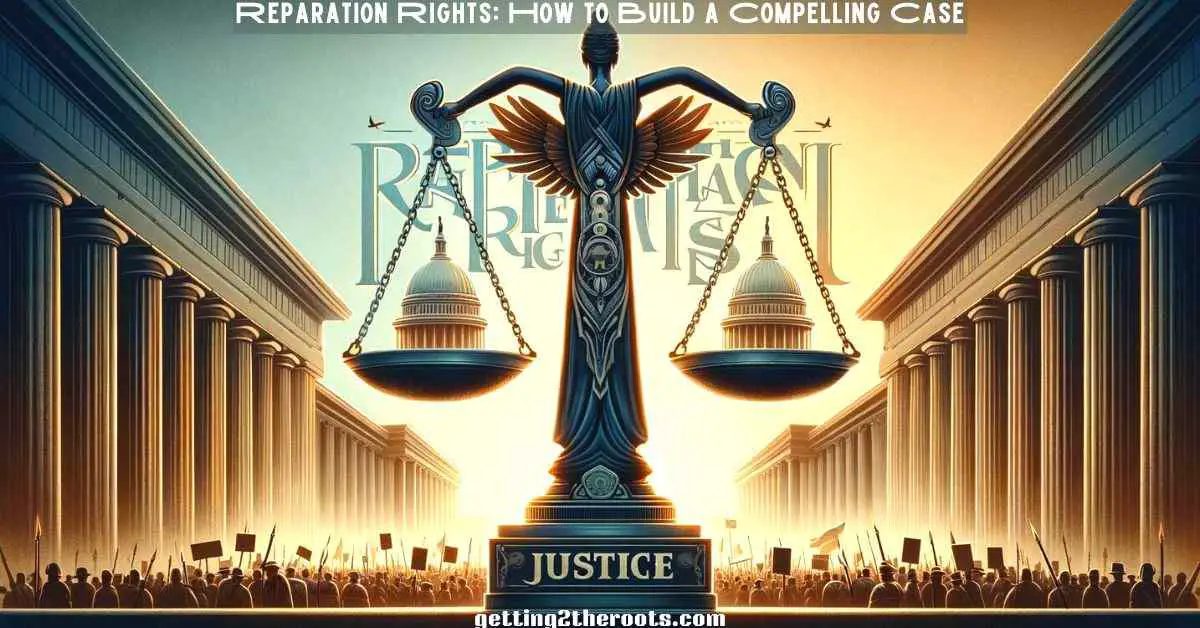
Overcoming Research Challenges in Reparation Rights
Dealing with Common Obstacles
Researching ancestry for reparation rights claims often encounters hurdles such as missing records and name changes.
These obstacles can make tracing lineages seem daunting. However, strategies exist to navigate these issues effectively.
For missing records, look for alternative sources that may provide the needed information, such as church records, newspaper archives, or court documents.
To effectively tackle the issue of name changes, which are common among ancestors who were enslaved.
It’s essential to adopt a flexible strategy. This process entails actively searching for variations in or phonetic spellings of names.
As a result, it ensures smoother tracing of lineage, effectively overcoming the challenges presented by these changes. Consequently, persistence and creativity become key to navigating these common obstacles.
Strategies for Researching in Regions with Poor Documentation
In areas where historical documentation is scarce or poorly maintained, traditional genealogical research methods may fall short.
- In such cases, broaden your search to include non-traditional sources.
- Subsequently, explore land use records, which can reveal family connections.
- And explore military records.
- Additionally, delve into local religious institutions’ archives for baptismal or marriage records.
- Finally, consider school records, which might provide unexpected insights.
Engaging with local historical societies or genealogical groups can also provide insights and access to resources that are not widely known or available.
These strategies require patience and may involve piecing together fragments of information to build a coherent ancestry narrative for reparation rights.
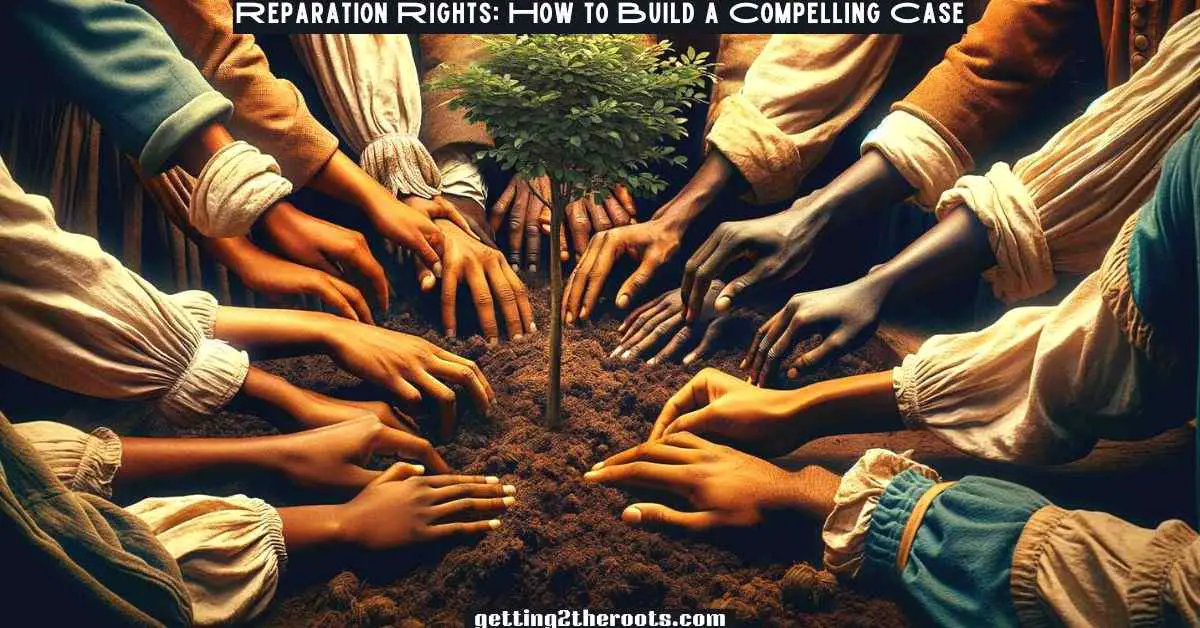
Utilizing Community Knowledge and Oral Histories
Community knowledge and oral histories are invaluable resources, especially in cultures with strong oral traditions or where historical records have been lost or destroyed.
These narratives can fill gaps left by official documents, providing personal details and contexts that enrich your family’s story.
Engaging with elders and community leaders can uncover stories and connections not found in any archive.
Additionally, oral histories can guide documentary research, offering clues for names, dates, and locations to investigate.
This approach not only aids in constructing a solid case for reparation rights but also preserves important cultural heritage.

Building Your Case for Reparation Rights
Organizing and Preserving Your Research Findings
Successfully building a case for reparation rights starts with careful organization of your research findings. Then, meticulously preserve these documents to ensure a strong foundation for your claim.
Start by creating a comprehensive and systematic filing system, whether digital or physical, to store all collected documents, records, and notes.
This system should allow for easy access and retrieval of information. Digitizing documents and using cloud storage can offer additional security and prevent the loss of data.
Moreover, regularly updating and backing up your research ensures that no part of your ancestral history is forgotten or misplaced, laying a strong foundation for your reparation rights claim.
Legal Considerations and Finding Legal Assistance
Understanding the legal framework surrounding reparation rights is crucial. This involves familiarizing yourself with the specific laws, policies, and precedents relevant to reparations in your region or country.
Since navigating legal complexities can be daunting, seeking legal assistance becomes imperative. Look for attorneys or legal clinics specializing in reparations or human rights law.
Many legal professionals are increasingly dedicating their practice to assisting with reparation rights claims, recognizing the importance of these cases.
Their expertise can guide you through the legal process, ensuring your claim is robust and compliant with all legal requirements.
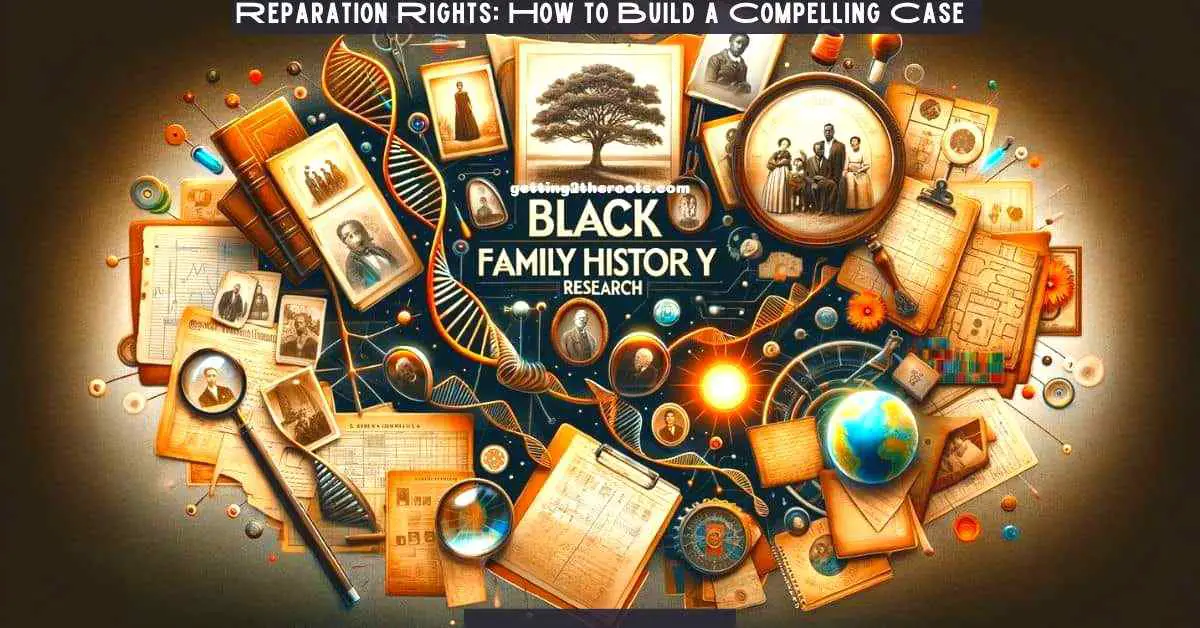
Preparing Your Reparations Claim: Documentation and Narrative
The final step in building your case for reparation rights involves preparing your claim, which includes compiling documentation and crafting a compelling narrative.
Your claim should succinctly summarize the evidence of your ancestry, the historical injustices faced, and the legal basis for reparations.
It is important to present your findings clearly and persuasively, highlighting the connection between past injustices and present-day impacts.
Including a personal narrative can also be powerful, as it puts a human face on the historical data and legal arguments.
This blend of emotional resonance and factual precision makes your reparation rights claim more compelling to decision-makers.
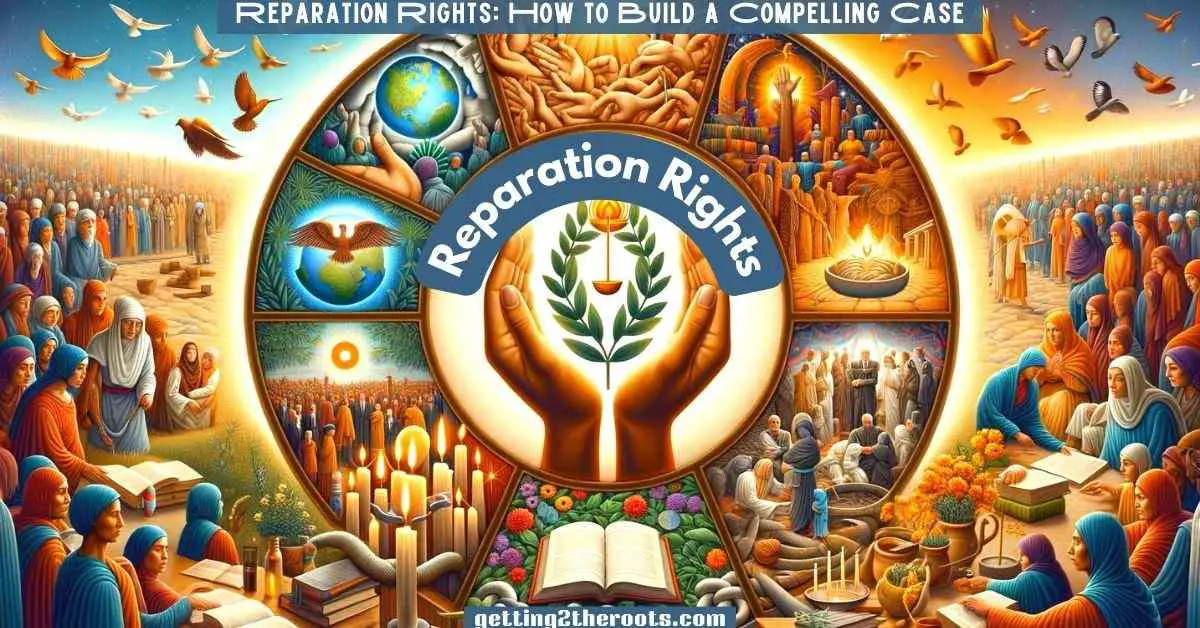
Beyond Individual Claims: Collective Efforts and Advocacy for Reparation Rights
Joining Forces with Others: The Role of Community and Organizations
The journey towards reparation rights is not solely an individual endeavor; it gains strength and momentum through collective action. Joining forces with others who are on similar paths can amplify your voice and impact.
Engaging with community groups, reparations advocacy organizations, and online forums can provide support, resources, and a platform for collective action.
These groups often organize events, workshops, and meetings that can educate and empower individuals in their quest for reparations.
Collaboration not only strengthens individual claims but also fosters a sense of solidarity and shared purpose among those seeking justice.
Advocacy Strategies for Reparations Legislation
Advocating for reparations legislation requires a multifaceted approach. It involves educating lawmakers and the public about the historical and moral grounds for reparations, lobbying for policy changes, and participating in public demonstrations and awareness campaigns.
- Writing op-eds, engaging with media, and using social media platforms can also raise awareness and support for the cause.
- Effective advocacy emphasizes the collective responsibility to address historical injustices and the positive societal impact of reparations.
- By pushing for legal and policy changes, advocates play a crucial role in shaping the future of reparation rights.
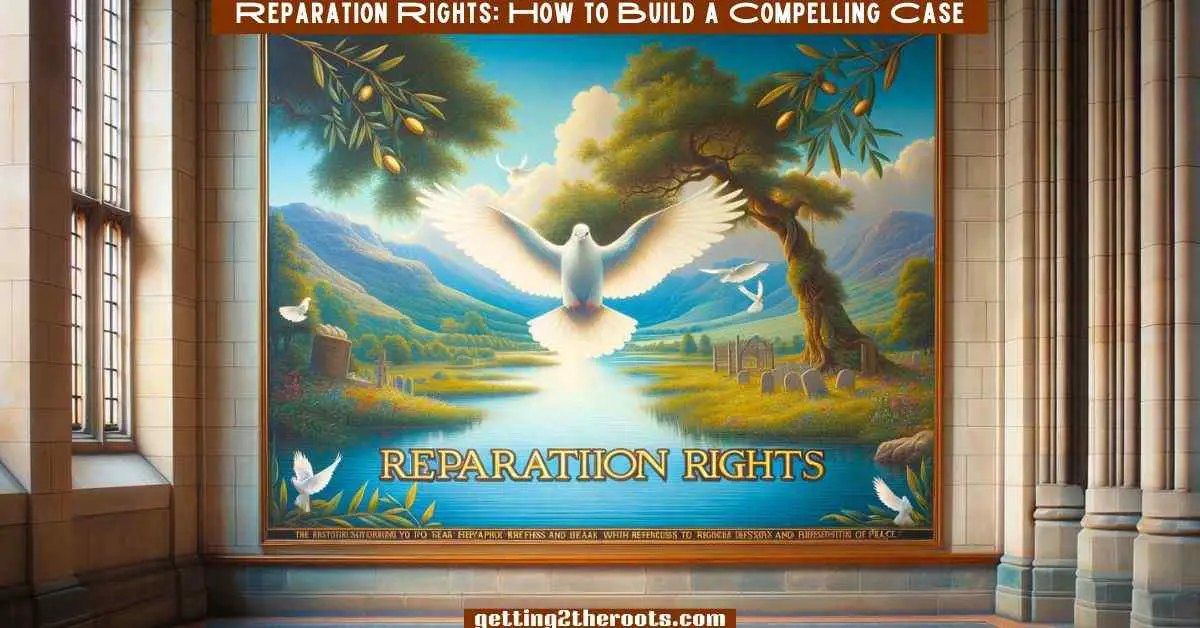
The Future of the Reparations Movement: Opportunities and Challenges
The reparation rights movement stands at a critical juncture, with growing awareness and support, yet facing significant challenges.
The opportunities lie in the increasing willingness of institutions, governments, and organizations to engage with the concept of reparations.
Innovative approaches to reparations, such as community development programs, educational scholarships, and public acknowledgments of historical injustices, are being explored.
However, challenges such as political resistance, differing opinions on the form reparations should take, and the logistical complexities of implementing reparations programs persist.
The movement’s success will depend on its ability to navigate these challenges, adapt to changing circumstances, and maintain momentum through continuous advocacy and collective action.
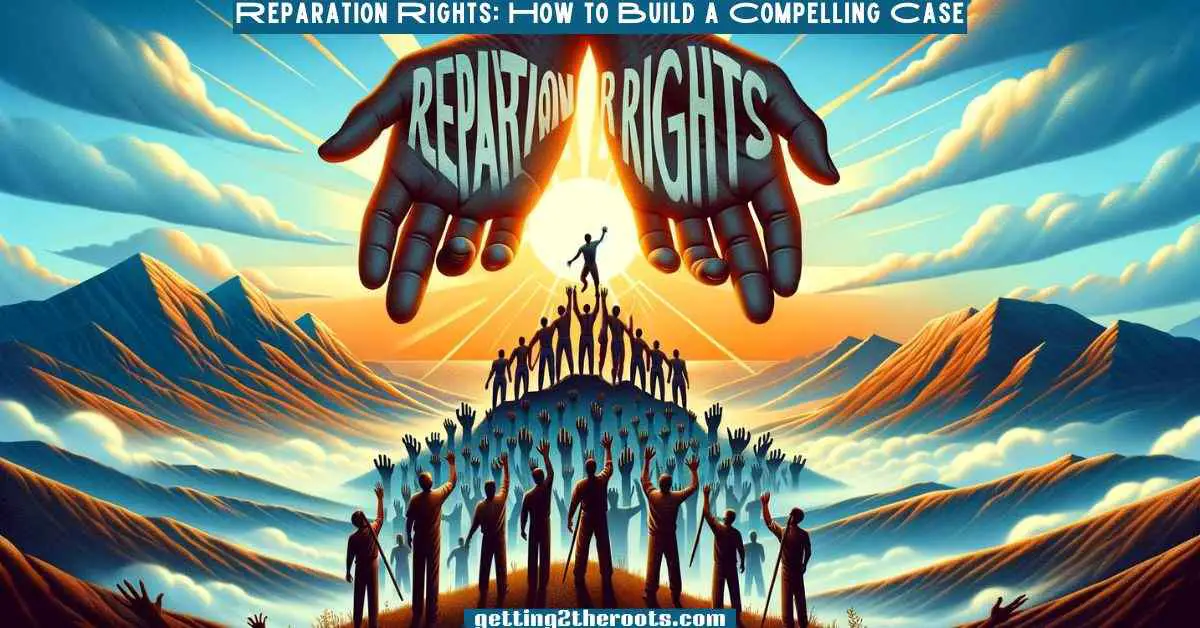
Recipients of Reparations from the United States
The United States has a complex history regarding the provision of reparations. This process entails actively searching for variations or phonetic spellings of names.
As a result, it ensures smoother tracing of lineage, effectively overcoming the challenges presented by these changes.
These instances highlight the government’s recognition of wrongdoing and its efforts, albeit limited to make amends.

Legacy of Redress: The Civil Liberties Act of 1988 and Japanese American Reparations
One of the most notable examples of reparations in the United States is the compensation provided to Japanese Americans who were interned during World War II.
The Civil Liberties Act of 1988 acknowledged the injustice of the internment, apologized for it, and granted reparations to surviving Japanese Americans who were interned.
Each eligible survivor received $20,000 and a formal apology from the U.S. government. This act was significant.
The acknowledgment by the federal government of the grave injustice done to Japanese American citizens and permanent residents during the war.
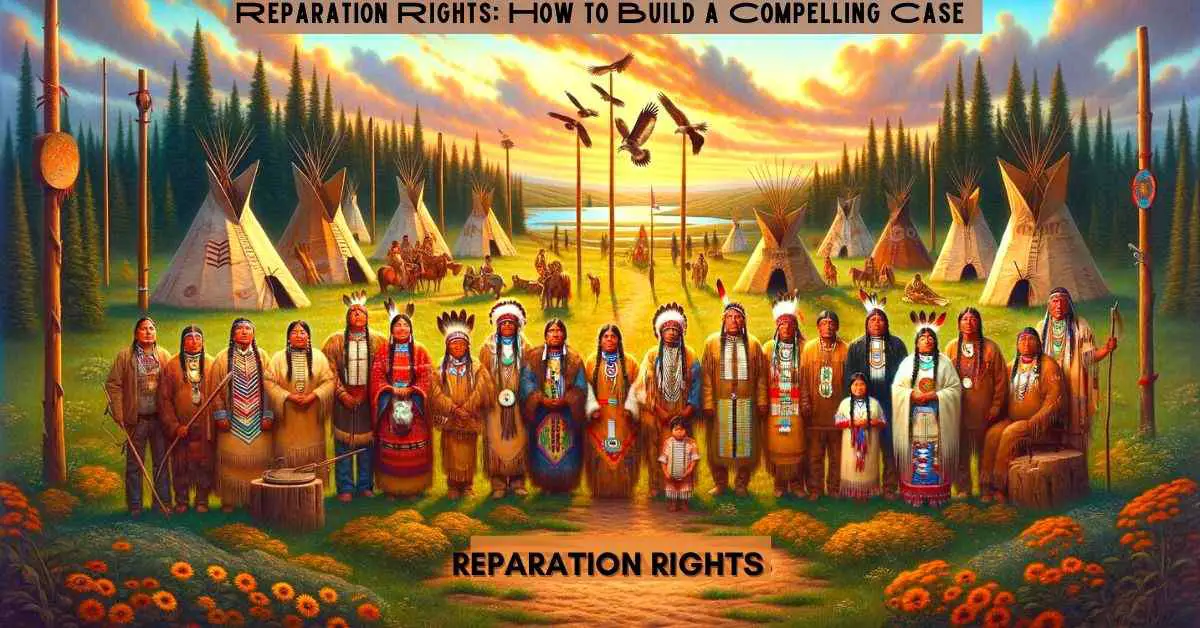
Paths to Healing: Reparations and Native American Tribes
Various Native American tribes have received reparations and settlements for the U.S. government’s breaches of treaties and mismanagement of tribal lands and resources.
These reparations have taken various forms, including financial compensation, land returns, and the establishment of trusts to support tribal development.
The Indian Claims Commission, established in 1946, was tasked with hearing and settling Native American claims against the United States for land cessions and other grievances.
While these efforts have provided some compensation, many Native Americans argue that the reparations have not fully addressed the extensive losses and damages suffered by Indigenous people.
The provision of reparations by the United States reflects a complex interplay of recognition, apology, and attempts at restitution for historical injustices.
Each case of reparations provides a precedent for acknowledging wrongs and attempting to make amends, yet also underscores the ongoing debates and challenges in fully addressing the impacts of these injustices.
The movement towards reparations remains a dynamic and evolving aspect of social justice advocacy in the United States, reflecting the nation’s ongoing struggle to reconcile with its past and provide justice for all its citizens.
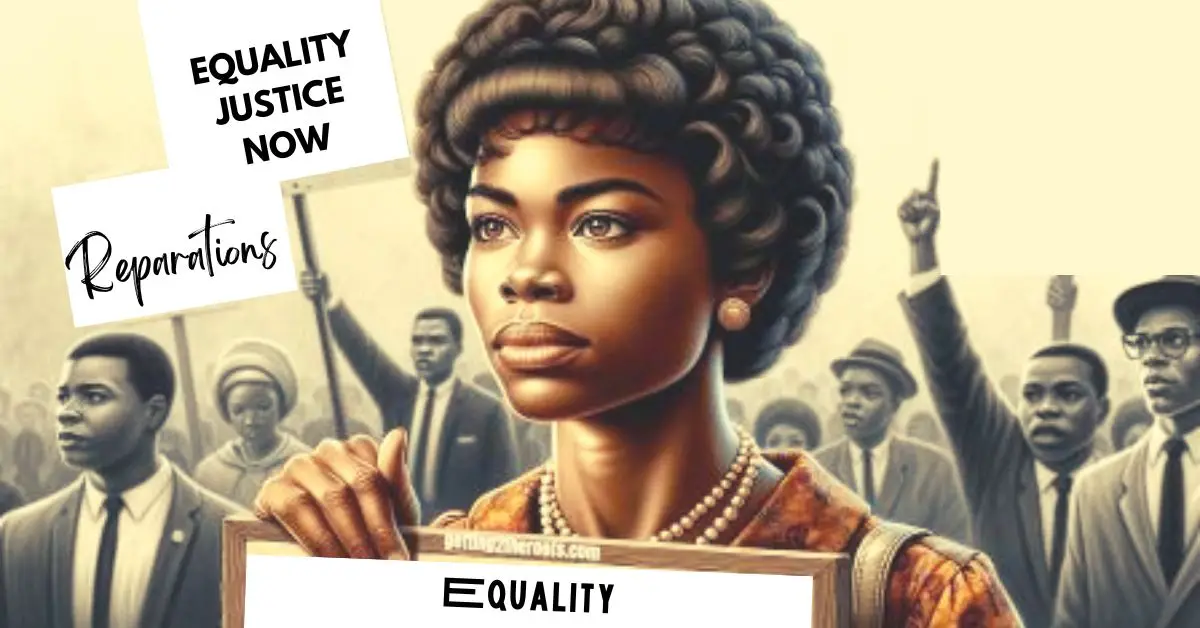
Embracing the Journey Toward Reparation Rights
Recap of Key Points and Steps in Proving Ancestry for Reparations
In our journey through understanding and claiming reparation rights, we’ve uncovered the importance of proving ancestry as a foundational step.
Starting with gathering initial evidence, engaging with genealogical resources, and navigating through vital records, we’ve seen how each piece of evidence brings us closer to substantiating claims for reparations.
Remember, leveraging census records, wills, property deeds, and even DNA testing plays a crucial role in building a compelling case.
Encouragement to Persist Despite Challenges
The path to securing reparation rights is fraught with challenges, from missing records to navigating complex legal landscapes.
Yet the importance of persistence cannot be overstated. Challenges are part of the journey, serving not only as obstacles but also as stepping stones towards achieving justice and recognition.
The effort to trace your lineage and fight for reparations is not just a personal endeavor but a profound act of reclaiming history and dignity.

The Broader Significance of Tracing One’s Roots Beyond Reparations
While the pursuit of reparation rights is a vital goal, the journey of tracing one’s ancestry unfolds broader significance.
It’s a deeply personal quest that connects individuals to their heritage, offering insights into family stories, struggles, and triumphs.
This exploration enriches one’s identity and fosters a deeper understanding of the historical contexts that have shaped lives and communities.
Beyond the potential financial or legal outcomes of reparations claims, the act of uncovering one’s roots is a powerful expression of resilience and belonging.
Conclusion
In conclusion, the quest for reparation rights is both challenging and deeply rewarding. It’s a pursuit that requires diligence, patience, and resilience.
Whether you’re embarking on this journey out of a desire for legal recognition, financial compensation, or a deeper connection with your ancestors.
This process of proving ancestry is a profound step toward acknowledging and rectifying historical injustices.
Let’s carry forward the lessons learned, the stories uncovered, and the connections made as we continue to advocate for justice and reparation rights.
Remember, every step taken enriches our understanding of the past and guides us toward a more just and equitable future.

Frequently Asked Questions (FAQs) on Reparation Rights
- Q: What are reparation rights? A: Reparation rights involve claims for actions to correct past injustices like slavery or genocide. These include financial aid, education, healthcare, and apologies.
- Q: Who qualifies for reparations? A: Eligibility varies by the injustice’s context, often requiring genealogical proof or documentation of ancestry related to the harm.
- Q: How do I prove my ancestry for reparations? A: Collect genealogical documents and consider DNA testing to establish lineage and familial connections for your claim.
- Q: Can you give examples of reparations programs? A: Programs include U.S. compensation to interned Japanese Americans, payments to Native American tribes, and Germany’s Holocaust reparations.
- Q: How can I support the reparations movement? A: Educate, donate to advocacy groups, lobby for legislation, and engage in discussions to promote awareness and support for reparations.

